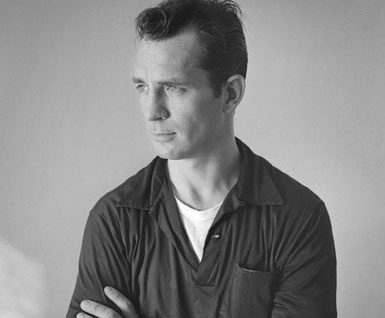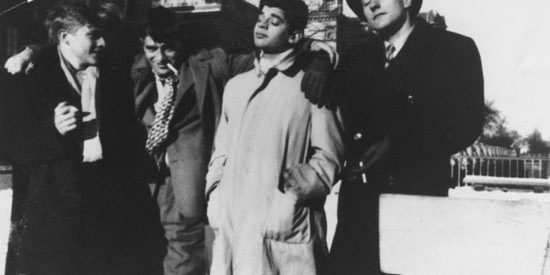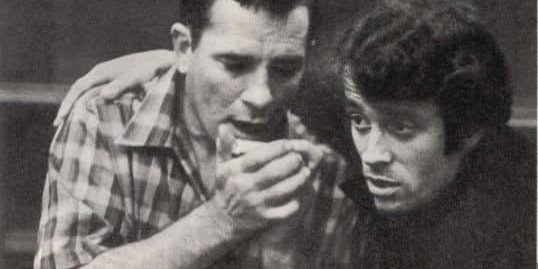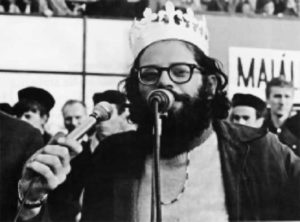
Novelist & Poet
Jack Kerouac
Jack Kerouac (1922-1969), born Jean-Louis Kirouac, was an American poet and novelist.
The son of French Canadian parents, Jack grew up in Lowell, Massachusetts in a family where French was routinely spoken in preference to English, and did not begin to learn English until he started school at the age of six.
Jack’s mother, Gabrielle-Ange Lévesque (1895-1973), was reportedly especially close to him in his childhood. She was a committed Roman Catholic, and brought up both Jack and his elder brother Gerard in this faith.
When Jack was just four, Gerard sadly died at the age of nine from an attack of rheumatic fever, but perhaps under the influence of the Catholic doctrine into which he had been raised, Jack felt his brother’s continuing presence in his life as his ‘guardian angel’; and he would go on in January 1956 to write a novel based on him called Visions of Gerard, which was belatedly published in 1963.
Jack’s father, Léo-Alcide Kéroack (1889-1946), was a farmer’s son who grew up in a village in the French-speaking Eastern Canadian province of Québec. Léo-Alcide was also a Christian, but earned a reputation in Jack’s eyes for treating preachers with pugnacious disdain, such as when he punched a rabbi who would not make way for the parents and Jack to pass by in the street in the 1940s, and when he threw a priest out of his home although his own wife had invited him in.
After attending Lowell High School, where he excelled in American Football, Kerouac moved to New York before his final year of High School, which he spent at Horace Mann School in Bronx. He then entered Columbia University on a sports scholarship, but his time there was fraught with problems. During his first year, he broke one of his legs during a match. In his second year, he suffered from a thorny relationship with his sports coach Lou Little, who kept him sidelined from matches in spite of his willingness to return to active play as he recovered from his fracture. Matters came to a head before the end of his second year, leading to him dropping out of Columbia altogether. He would later attend the New School, a private research university in New York City, to study literature.
While at Columbia, he met an art student there called Edie Parker (1922-1993) and began to live with her. In spite of his dropping out, they continued to live together in New York City. Eventually, in 1944, they were married, but the marriage was annulled just four years later in 1948.

In 1942, Kerouac enrolled in the United States armed forces, initially joining the Merchant Marine, before moving in 1943 to the Navy. However, after only eight days in the navy, he reported sick and, after being assessed by the medical examiner, was diagnosed with ‘schizoid personality’ and honourably discharged on psychiatric grounds.
During his time in the Merchant Marine, Jack wrote his first novel, The Sea Is My Brother, which however would not be published until 2011, long after his death, because he himself was not satisfied that it was worthy of publication.
In the years he spent in New York, Kerouac had begun to make friends with a circle of writers who would become prominent members of the Beat Generation, including Lucien Carr, who subsequently introduced him to both Allen Ginsburg and William S. Burroughs.
In 1942, Kerouac enrolled in the United States armed forces, initially joining the Merchant Marine, before moving in 1943 to the Navy. However, after only eight days in the navy, he reported sick and, after being assessed by the medical examiner, was diagnosed with ‘schizoid personality’ and honourably discharged on psychiatric grounds.
During his time in the Merchant Marine, Jack wrote his first novel, The Sea Is My Brother, which however would not be published until 2011, long after his death, because he himself was not satisfied that it was worthy of publication.
In the years he spent in New York, Kerouac had begun to make friends with a circle of writers who would become prominent members of the Beat Generation, including Lucien Carr, who subsequently introduced him to both Allen Ginsburg and William S. Burroughs.
In 1944, in a notorious episode, Carr stabbed to death an older man he felt had been stalking him with sexual motives for years, David Kammerer. After dumping Kammerer’s body in the Hudson River, Carr confessed to Kerouac what he had done, and Kerouac helped him cover up the crime by disposing of the knife and burying the victim’s glasses. However, Carr was then persuaded by Burroughs to turn himself in to the police, resulting in Kerouac’s arrest as a material witness. Kerouac was remanded in custody, and his father refused to pay his bail, but Edie paid it instead after they were summarily married so she could access an inheritance that would allow her to help him out.
Kerouac and Burroughs subsequently worked together on a novel about Kammerer’s murder called And the Hippos Were Boiled In Their Tanks, but it was not finally published until 2008, well after both of their lifetimes.
I hope it is true that a man can die and yet not only live in others but give them life, and not only life but that great consciousness of life.
In the later 1940s, Jack’s parents belatedly moved to New York in their turn, leading to him moving back in with them after he and Edie had decided to separate. This heralded the beginning of a busy period for his writing, including his first published novel, The Town and the City, which was published in 1950, and his second and most famous novel, On the Road, which followed in 1957, although he had begun work on it as early as 1949 and completed it in 1951.
In 1950, Kerouac met and fell in love with a young widow, Joan Haverty (1931-1990), whose husband, lawyer Bill Cannastra (1921-1950), had recently been killed at the age of 28 while trying to climb out of the window of a New York subway train carriage. After taking her to meet his mother at the home he still shared with his parents, Jack immediately proposed marriage to Joan, and they were married just two weeks later. Soon afterwards, she had moved in with him at an apartment in West 20th Street, Manhattan, and Joan quickly became pregnant, but she left him after just eight months of marriage in 1951, before their son, Jan, was born. During their brief marriage, Jack had been working intensively on the completion of the manuscript for On the Road.
In the later 1940s, Jack’s parents belatedly moved to New York in their turn, leading to him moving back in with them after he and Edie had decided to separate. This heralded the beginning of a busy period for his writing, including his first published novel, The Town and the City, which was published in 1950, and his second and most famous novel, On the Road, which followed in 1957, although he had begun work on it as early as 1949 and completed it in 1951.
In 1950, Kerouac met and fell in love with a young widow, Joan Haverty (1931-1990), whose husband, lawyer Bill Cannastra (1921-1950), had recently been killed at the age of 28 while trying to climb out of the window of a New York subway train carriage. After taking her to meet his mother at the home he still shared with his parents, Jack immediately proposed marriage to Joan, and they were married just two weeks later. Soon afterwards, she had moved in with him at an apartment in West 20th Street, Manhattan, and Joan quickly became pregnant, but she left him after just eight months of marriage in 1951, before their son, Jan, was born. During their brief marriage, Jack had been working intensively on the completion of the manuscript for On the Road.
The original manuscript for On the Road was widely rejected by publishers because of its explicit content relating to sex and the use of recreational drugs, as well as, in some cases, because of their editors’ unease with Kerouac’s experimental writing style.
While struggling to secure a publisher for what would eventually become his second published novel, Kerouac had returned once again to living with his parents, and took on a job on the railroads, operating the brakes and serving as a fire lookout, in connection with which he travelled widely between the East and West coasts of the USA. He suffered from bouts of depression and sometimes turned to the heavy consumption of alcoholic drinks, all the while continuing to work on other novels.

In 1953, Kerouac met Alene Lee (1931-1991), an African-American woman, who was working as a typist for fellow beat-writer Allen Ginsburg in the apartment of the latter. Kerouac and Lee embarked on a short-lived love affair. She inspired a character called Mardou Fox in his third published novel The Subterraneans (written 1953, published 1958), which also featured characters based upon Burroughs and Ginsberg, as well as other famous writers of the era such as Gore Vidal and Neal Cassady.
In 1954, Jack began to study Buddhism. For part of the following two years, he stayed with his married sister in the state of North Carolina, finding the space in her home to meditate deeply and to write his own book on Buddhism called Some of the Dharma. In 1955, he also wrote a biography of the Buddha called Wake Up: a Life of the Buddha, which remained unpublished until 2008, long after his own death. Late in 1957, Kerouac further wrote a short account of his personal experiences with Buddhism, The Dharma Burns, which was published the following year, but it received a frosty reception from Buddhist teachers and writers such as D. T. Suzuki (1870-1966).
His own use of marijuana, coupled with his fictitious characters typically having sexually libertine lifestyles, earned Kerouac and his writing the disapproval of American conservatives. However, he was no more popular with those on the American political left, because he opposed communism and retained his allegiance to the Catholic faith in which he had been raised.
On the Road was finally accepted for publication by Viking Press in 1957 on condition of the manuscript being toned down, with many sexually explicit passages removed. In spite of this censorship, it proved a critical and commercial success, earning him fame, and has since come to be regarded as the defining literary work of the Beat Generation.
Such was the high profile that the success of this book gave him that Kerouac came to be widely recognised in public, where he ceased to feel safe. His concerns were vindicated when he was beaten up by a gang of three men outside a café in New York City.
In 1959, Kerouac contributed the writing and narration to a film called Pull My Daisy, named after a poem he first wrote in the late 1940s. During his life, he wrote many other poems that were eventually published, although many of them only posthumously as parts of anthologies. His published works of poetry include San Francisco Blues (written 1954, published 1983), Mexico City Blues (written 1955, published 1959), The Scripture of the Golden Eternity (written 1956, published 1960), Old Angel Midnight (written 1956, published 1973), Scattered Poems (written 1945-1968, published 1971), Pomes All Sizes (compiled 1960, published 1992), and Book of Haikus (published 2003). A further anthology entitled Collected Poems was published in 2012.
The success of On the Road created a demand among publishers to release many of his other manuscripts that had previously been rejected. Beyond the belated appearance of The Subterraneans, several other novels on which he had already begun work in the early-mid 1950s were published after On the Road and within his lifetime, including Doctor Sax (written 1952, published 1959), Maggie Cassidy (written 1953, published 1959), Tristessa (written 1955-6, published 1960), Book of Dreams (written 1952-1960, published 1960), Desolation Angels (commenced 1956, completed 1961, published 1965), and Visions of Gerard (written 1956, published 1965).
In the 1960s, although he continued to write from time to time, his career success waned, and he descended into alcoholism and poverty. In the mid-1960s, he was hit hard by tragedy in his family, as his sister died from a heart attack in 1964 and his mother suffered a debilitating stroke in 1966. His friend Neal Cassady died while abroad in Mexico in 1968, and around the same time, he became alienated from his former friend Ginsberg over differences of opinion regarding the counterculture movement.
His relatively few novels that were both written and published in the 1960s include Lonesome Traveler (1960), Big Sur (written 1961, published 1962), Satori in Paris (1966), and Vanity of Duluoz (written 1967, published 1968).
In the meantime, in 1966, Jack had got married for a third time, to Stella Sampas (1918-1990), a fellow native of Lowell four years his senior.
In October 1969, Kerouac was himself suddenly taken ill with nausea. After vomiting blood, he was taken to hospital, where he was diagnosed with an oesophagal haemorrhage. After undergoing an emergency operation under general anaesthesia, he died without regaining consciousness. Cirrhosis of the liver caused by long-term alcohol abuse was listed as a cause of his haemorrhage on his death certificate.
He was survived by Stella, who inherited his estate and outlived him by more than twenty years.
Several of his early works have appeared in print only posthumously, including, in addition to those already mentioned above, Pic (begun 1951, completed 1969, published 1971), Visions of Cody (written 1951-2, published 1972), Orpheus Emerged (written 1944-5, published 2000), and The Haunted Life and Other Writings (written 1944, published 2014).
On the Road was recently adapted into a film directed by Walter Salles and produced by Francis Ford Coppola, which was released in 2012. A film adaptation of Big Sur by Michael Polish also appeared the following year (2013).
In 1974, in Jack’s honour, his erstwhile friend Ginsberg opened the Jack Kerouac School of Disembodied Politics at a private Buddhist university in Boulder, Colorado, called Naropa University.
In 2007, the University of Massachusetts Lowell awarded Kerouac, one of Lowell’s most famous natives, a posthumous honorary Doctorate of Letters.

